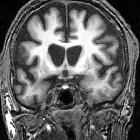neurodegeneration with brain iron accumulation





Neurodegeneration with brain iron accumulation (NBIA), is a heterogeneous group of rare genetic disorders characterized by accumulation of iron in the basal ganglia, which results in variable neurological disorders including extrapyramidal symptoms, neuropsychiatric and visual.
Numerous genes (at least 10) have been identified, resulting in a variety of specific diseases :
- pantothenate kinase-associated neurodegeneration (PKAN)
- most common form accounting for 35-50% of NBIA
- previously known as Hallervorden-Spatz syndrome
- PLA2G6-associated neurodegeneration (PLAN)
- accounts for ~20% of NBIA
- mitochondrial membrane protein-associated neurodegeneration (MPAN)
- accounts for ~6-10% of NIBA
- beta-propeller protein-associated neurodegeneration (BPAN)
- accounts of 1-2% of NIBA
- infantile neuroaxonal dystrophy (INAD) / atypical neuroaxonal dystrophy (NAD)
- aceruloplasminaemia
- COASY protein-associated neurodegeneration (COPAN)
- fatty acid hydroxylase-associated neurodegeneration (FAHN)
- Kufor-Rakeb syndrome
- neuroferritinopathy
- Woodhouse-Sakati syndrome
Epidemiology
No single demographic is affected, and epidemiology varied depending on the specific condition, ranging from infancy to old age .
Clinical presentation
Patients with NBIA suffer from a variety of neurological symptoms and signs including :
- extrapyramidal symptoms
- dystonia, muscular rigidity, spasms, parkinsonism
- neuropsychiatric
- optic atrophy
- retinal degeneration
Radiographic features
Radiographic features will vary among the various entities, but can broadly be thought of as :
- basal ganglia signal abnormalities
- cerebellar and cerebral atrophy
Treatment and prognosis
Although therapies will vary, dystonia is being treated with deep brain stimulation as well as oral or intrathecal baclofen .
Renewed interest in iron chelation is now present with the development of deferiprone .
Siehe auch:
- Globus pallidus
- substantia nigra
- Demyelinisierende Erkrankung
- eye of tiger sign
- Chorea Huntington
- Nucleus caudatus
- Retinitis pigmentosa
- infantile Neuroaxonale Dystrophie
- SENDA syndrome
und weiter:

 Assoziationen und Differentialdiagnosen zu Neurodegeneration mit Eisenablagerung im Gehirn:
Assoziationen und Differentialdiagnosen zu Neurodegeneration mit Eisenablagerung im Gehirn:




